Last updated: August 23, 2017
Article
Using Observers to Record Encounters Between Cruise Ships and Humpback Whales
By Scott M. Gende, Karin Harris, Julie Nielsen, and A. Noble Hendrix
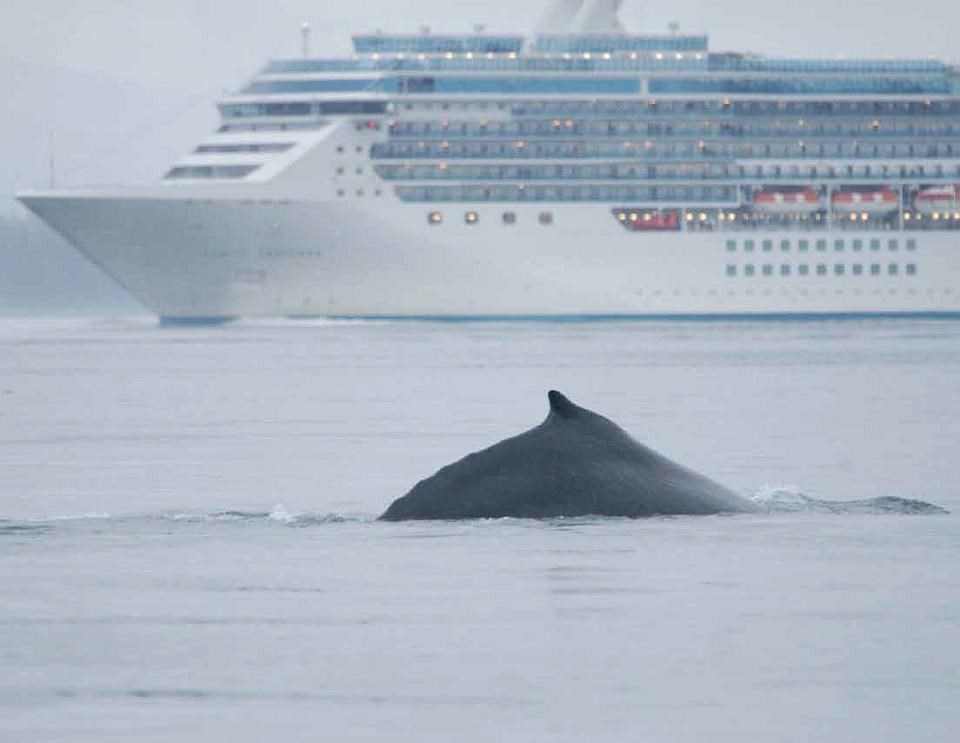
In the early morning of July 12, 2001, the cruise ship Dawn Princess entered Glacier Bay National Park and Preserve, as it had on a number of occasions that year. After spending the day in Glacier Bay, the ship, measuring over 850 feet long and carrying nearly 3000 passengers and crew, headed back toward the mouth of the park, in clear weather and calm seas. Just after 2:30 pm as the ship neared Bartlett Cove, the captain reduced the ship’s speed to allow NPS interpretive rangers to disembark to the ranger boat that had come along side. After the transfer, the ship increased its speed and began its transit outside the park to Icy Strait.
According to reports, as the ship increased speed several humpback whales were sighted approximately 700 yards (640 m) off the left side of the ship headed in a direction of the ship’s path. Although the ship was accelerating, it did not alter its course and neither did the whales. At last sighting, the whales were so close to the ship that they could no longer be seen under the ship’s prow. Thereafter, some passengers reported hearing a “resounding thud”. Other passengers said they heard or felt nothing at all. Neither of the whales were seen re-surfacing on the other side of the ship, the incident went unreported to the NPS, and the ship continued to its next port of call.
Four days later, a dead humpback whale was discovered bloated and floating near the area where the encounter occurred. A necropsy performed several days later found that the whale had a fractured skull and vertebrae, and likely died as a result of the massive blunt trauma it sustained to the right side of its head. It was also discovered that the whale was pregnant at the time of death.
Unintentional ship-whale encounters have increased over the past few decades as whale populations rebound from the large-scale commercial whaling in the 1950s and 1960s, and as the number and size of ships plying the world’s waters have increased. In Glacier Bay, encounters between cruise ships and humpback whales have also likely increased for the same reasons. In 1970, cruise ships entered the park on 55 different occasions, but by 2009 that number had risen to 224, an increase of over 300%. Likewise, monitoring efforts in 1985 recorded 41 individual humpback whales using the waters in Glacier Bay and Icy Strait. By 2009, that number had surpassed 150, an increase of over 270%.
Encounters between cruise ships and humpback whales represent a perplexing issue for park management, reflecting trade-offs between resource protection and visitor experience. Although no formal surveys have been conducted, we have interacted with hundreds of cruise passengers over the past five years and found two recurring themes: (1) sighting a humpback whale represents one of the most thrilling experiences by cruise ship passengers, and (2) the closer the encounter, the more thrilling the experience. For example, one of the most common questions we are asked by passengers is when and where they are most likely to see whales. It’s also hard not to notice the excitement of the wide-eyed passengers yelling to no one in particular that the whales were so close they could “see down the blowhole!” For many of these passengers, seeing whales may be a once-in-a-lifetime event, which undoubtedly invokes a keener appreciation for conservation and natural history, clearly consistent with the NPS mandate.
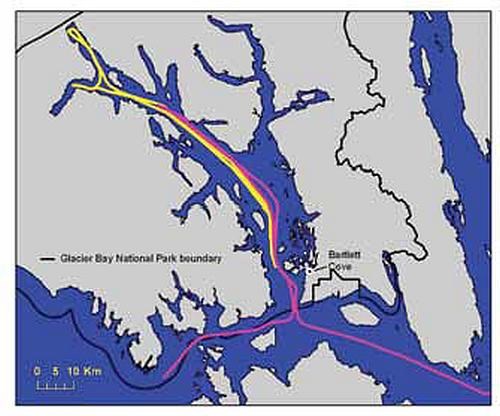
Nevertheless the same encounters coveted by passengers could have adverse impacts on individual whales, and ultimately affect the population using the park and adjacent waters. For example, the underwater noise produced by the propulsion systems of cruise ships may be sufficiently loud to degrade the whale’s acoustic habitat (Gabriele et al. this issue) and mask vital communi-cation for whales. As a general rule, the closer that ships encounter whales the louder the noise exposure, and thus the higher likelihood of impacting communication. If encounters between whales and ships are too close, lethal collisions may occur thereby directly impacting the number of whales using Glacier Bay, both the year it occurred and in the future (Gende and Hendrix this issue).
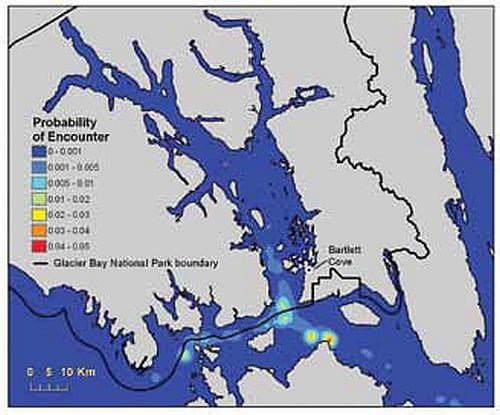
Recognizing this potential impact, the Glacier Bay Science Advisory Board recommended as one of its top research priorities that the NPS place observers aboard the ships to record how often and how close cruise ships encounter humpback whales and other marine life. Beginning in July 2006, observers began spending the day aboard the ships while they were in the park. Observers, transferred out to the ships with the NPS interpretive rangers, position themselves on the bow with rangefinder binoculars and handheld GPS units, and record encounters beginning and ending near Bartlett Cove (Figure 2). After 2007, however, it was apparent that many of the encounters between ships and whales were occurring before or after the observers embarked/disembarked, particularly at the mouth of Glacier Bay and in adjacent Icy Strait. Thus, beginning in 2008, with funding provided by the National Fish and Wildlife Foundation and the Pacific Life Foundation, and in cooperation with the University of Washington and University of Alaska Southeast, observers began boarding ships in Skagway and Juneau to record encounters in Icy Strait and at the entrance of the park. Observers would then disembark at the ship’s next port of call (Ketchikan or Sitka), fly back to Juneau and repeat.
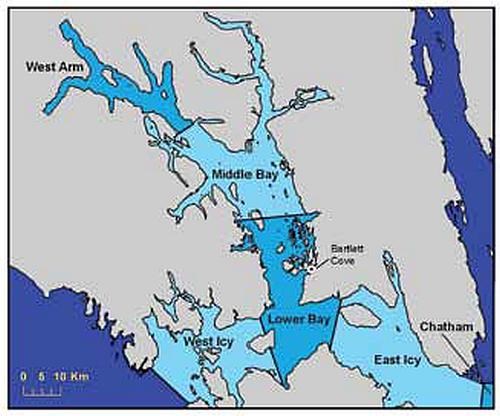
Although analyses of these data are ongoing, simple descriptive statistics have revealed some management-relevant results. Foremost, encounters between cruise ships and whales are frequent, with many encounters occurring close to the ships. After truncating the maximum encounter distance to 3,281 ft (1 km), about 20% of the ship-whale encounters occurred within 985 ft (300 m) of the bow. Although only about 3% of these encounters were less than 328 ft (100 m), by any measure these encounters represent ‘near misses’. For example, an adult whale swimming perpendicular toward the ship’s path at a typical speed of 7.2 ft/sec (2.2 m/sec), from 165 ft (50 m) away has about 6 seconds to avoid a collision with a ship moving at a speed of 16 knots (about 26 ft/sec or 8 m/sec).
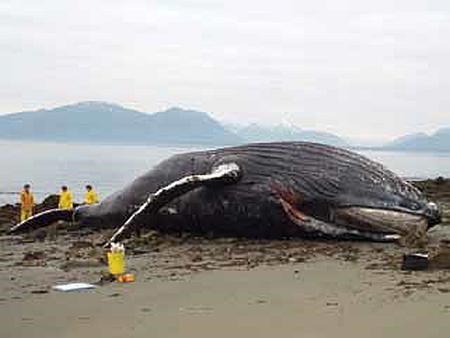
NPS Photo
(Figure 4) and in time demonstrates that the probability of an encounter differs dramatically among sub-regions and among months. For example, summing up the total number of encounters between whales and ships less than 1/4 mile (402 m) in each sub-region and dividing by the total number of ship entries into that sub-region reveals that the probability of an encounter is always high in the Lower Bay sub-region, particularly during the June-August peak season compared to the Middle Bay and West Arm sub-regions (Figure 8). However, high rates of encounters, undoubtedly with the same group of whales using Glacier Bay, can also occur in Icy Strait. These data suggest that park regulations for managing ships during peak versus ‘shoulder’ seasons, and instigating seasonal speed restrictions in the lower section of Glacier Bay are solid management actions, but should be considered in Icy Strait by the state of Alaska.
Ultimately, encounters between cruise ships and humpback whales are inevitable as long as both are plying the relatively confined areas of Icy Strait and Glacier Bay. What remains to be determined is whether these encounters adversely affect the whales using Glacier Bay and Icy Strait (Gende and Hendrix this issue), and the chance of another lethal collision between a whale and ship. Whether the level of cruise ships and associated visitation justifies the impacts to humpback whales will continue to be a significant management question. For now, the passengers will continue to enjoy experiencing these encounters, we will continue to to record and analyze their impacts, and managers will need to ultimately weigh both the visitor levels and rates of encounters to make decisions regarding quotas of cruise ships.

